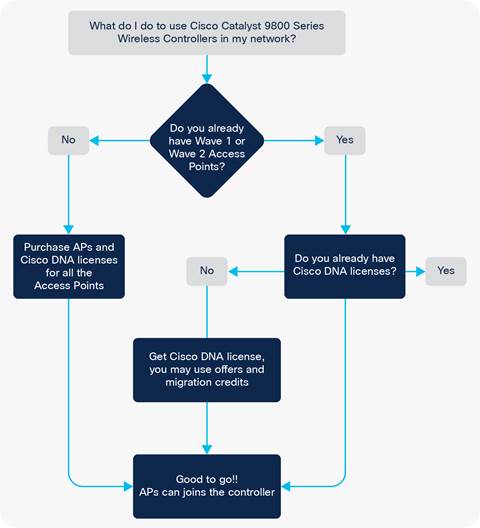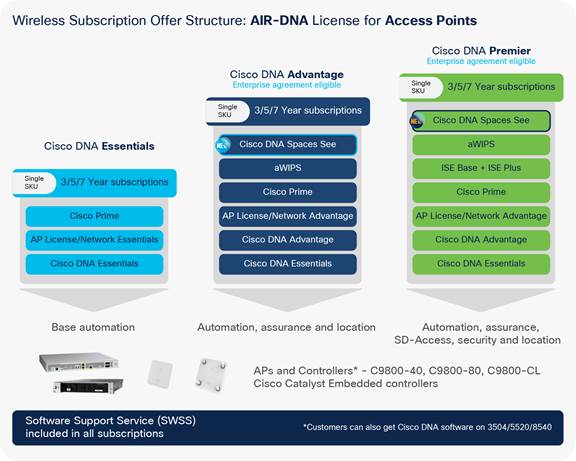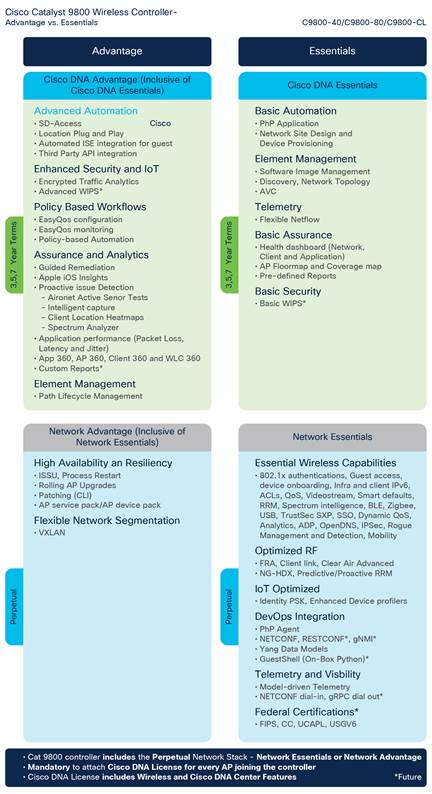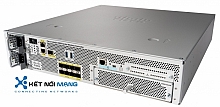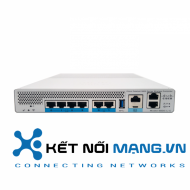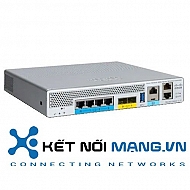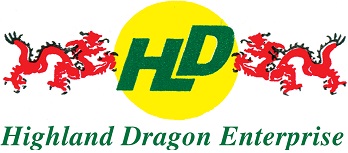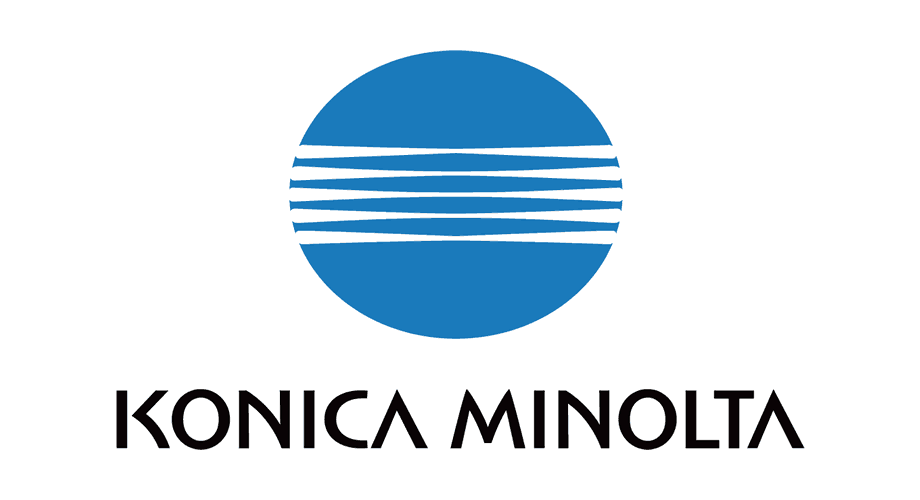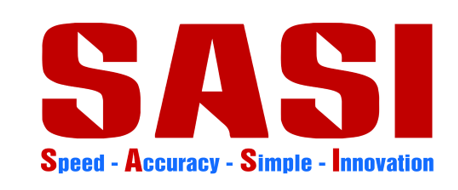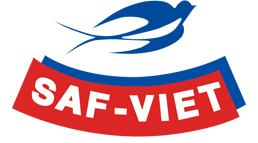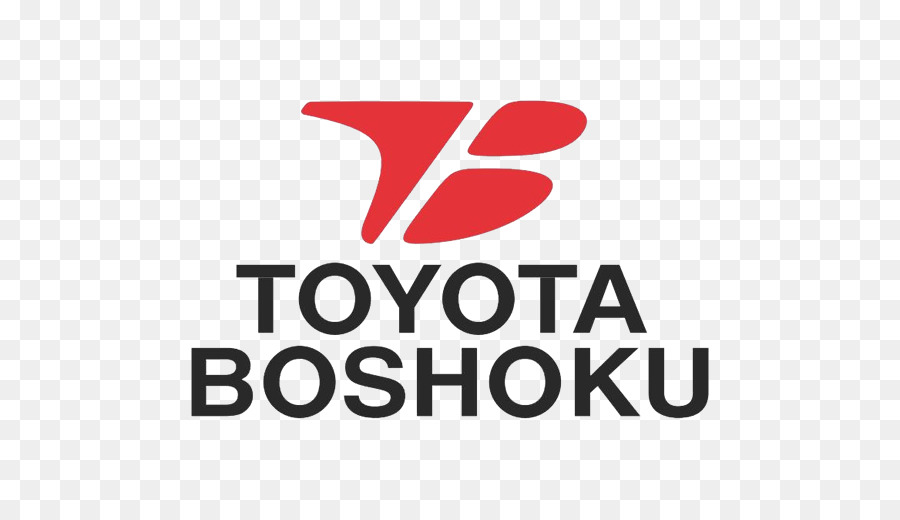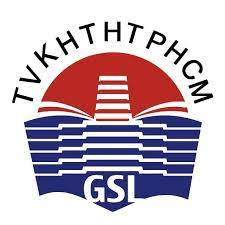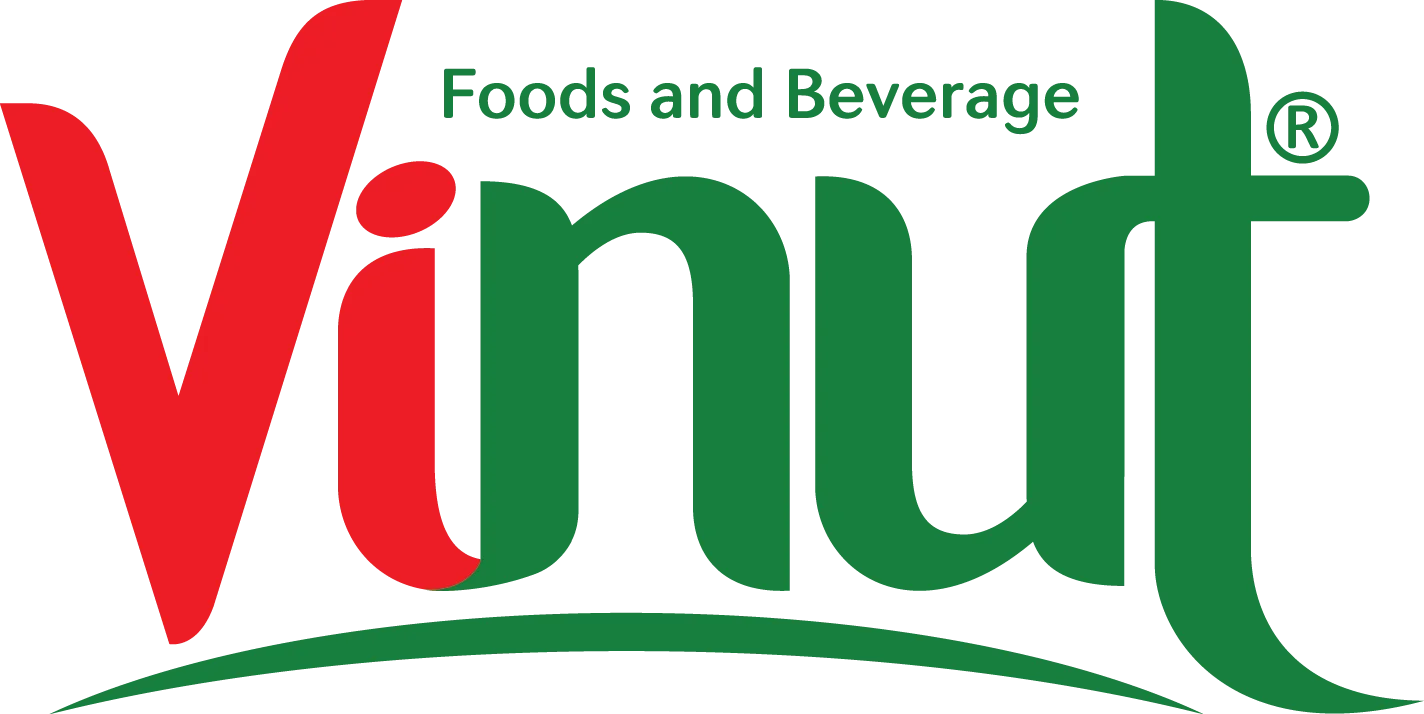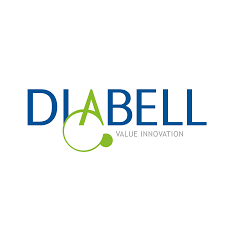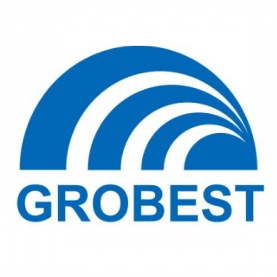Cisco Meraki MS120-8 Switch
Cisco Meraki MS120-48FP Switch
Cisco Meraki MS125-24 Switch
Cisco Meraki MS125-48FP Switch
Cisco Meraki MS120-48LP Switch
Cisco Meraki MS125-48 Switch
Cisco Meraki MS120-8LP Switch
Cisco Meraki MS125-24P Switch
Cisco Meraki MS125-48LP Switch

Dịch vụ bảo hành Cisco CON-SNT-C9800LCL SNTC-8X5XNBD Cisco Catalyst 9800-L Wireless Controller
P/N: CON-SNT-C9800LCLSNTC-8X5XNBD Cisco Catalyst 9800-L Wireless Controller
Liên hệ ngay
Built from the ground up for intent-based networking
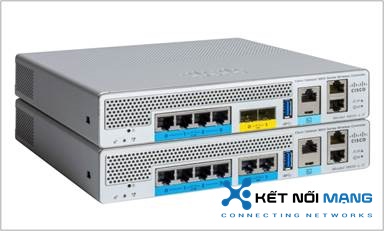
The Cisco® Catalyst® 9800-L is a fixed wireless controller with seamless software updates for small and midsize enterprises.
Built from the ground up for intent-based networking, the Cisco Catalyst 9800-L brings together Cisco IOS® XE Software and Cisco RF excellence to create a best-in-class wireless experience for your evolving and growing organization.
The Cisco Catalyst 9800-L is feature rich and enterprise ready to power your business-critical operations and transform end-user experiences:
- Choose between copper and fiber uplinks. This choice gives you flexibility in your network.
- High availability and seamless software updates, enabled by hot and cold patching, keep your clients and services always on in planned and unplanned events.
- Secure the air, devices, and users with the Cisco Catalyst 9800-L. The wireless infrastructure becomes the strongest first line of defense, with Encrypted Traffic Analytics and Software-Defined Access (SD-Access). The controller comes with built-in security: Secure Boot, runtime defenses, image signing, integrity verification, and hardware authenticity.
- Built on a modular operating system, the controller features open and programmable APIs that enable automation of day-0 to day-N network operations. Model-driven streaming telemetry provides deep insights into your network and client health.
Product overview:
Key features
|
Feature |
Description |
|
Maximum number of access points |
250 |
|
Maximum number of clients |
5000 |
|
Maximum throughput |
5 Gbps |
|
Maximum WLANs |
4096 |
|
Maximum VLANs |
4096 |
|
Fixed uplinks |
2x 10G/Multigigabit copper or 2x 10G/Multigigabit fiber |
|
Power supply |
110W, 12VDC, AC/DC adapter |
|
Maximum power consumption |
9800-L-C: 86.9W (with 4.5W USB load) 9800-L-F: 84.5W (assumes 2pc 2.5W SFP and with 4.5W USB load) |
|
Deployment modes |
Centralized, Cisco FlexConnect®, and fabric |
|
Form factor |
1RU; half-width chassis allows side-by-side installation in standard 19-in. rack |
|
License |
Smart License enabled |
|
Software |
Cisco IOS XE |
|
Management |
Cisco DNA Center, Cisco Prime® Infrastructure, and third party (open standards APIs) |
|
Interoperability |
AireOS-based controllers |
|
Access points |
Cisco Aironet® 802.11ac Wave 1 and Wave 2 access points, Cisco Catalyst 9100 802.11ax access points |
Always on
The Cisco Catalyst 9800-L provides seamless software updates for faster resolution of critical issues, the ability to introduce new access points with zero downtime, and flexible software upgrades. Stateful Switchover (SSO) with active standby and N+1 redundancy keeps your network, services, and clients always on, even in unplanned events.
Secure
Secure the air, devices, and users with the Cisco Catalyst 9800-L. Wireless infrastructure becomes the strongest first line of defense with Encrypted Traffic Analytics and SD-Access. The controller comes with built-in security: Secure Boot, runtime defenses, image signing, integrity verification, and hardware authenticity.
Open and programmable
The Cisco Catalyst 9800-L controller is built on the Cisco IOS XE operating system, which offers a rich set of open standards-based programmable APIs and model-driven telemetry that provide an easy way to automate day-0 to day-N network operations.
Platform details
Physical dimensions
|
Dimension |
Value |
|
Width |
8.5 in. (21.59 cm) |
|
Depth |
9.06 in. (23.01 cm) |
|
Height |
1.58 in. (4.02 cm) |
|
Weight |
C9800-L-C: 3.95 lb. (1.79 kg) C9800-L-F: 4.01 lb. (1.82 kg) |
Front panel

Cisco Catalyst 9800-L-C front panel

Cisco Catalyst 9800-L-F front panel
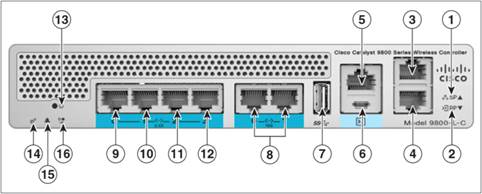
Cisco Catalyst 9800-L -C front panel with components labeled
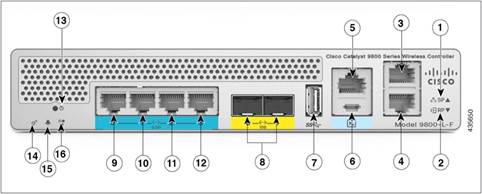
Cisco Catalyst 9800-L-F front panel with components labeled
Cisco Catalyst 9800-L front panel components
|
Label |
Description |
|
1 |
Service port LED |
|
2 |
Redundancy port LED |
|
3 |
Service Port (SP) (RJ-45) for out-of-band management |
|
4 |
Redundancy port |
|
5 |
RJ-45 console port |
|
6 |
Mini-B USB console |
|
7 |
USB 3.0 port |
|
8 |
2x 10G/Multigigabit copper (Figure 4) 2x 10G/Multigigabit fiber (Figure 5) |
|
9-12 |
Quad RJ-45 2.5G/1G Multigigabit Ethernet ports |
|
13 |
Reset button |
|
14 |
System LED |
|
15 |
Alarm LED |
|
16 |
High availability LED |
Ports
|
Port |
Description |
|
1x RJ-45 console port |
Console port for out-of-band management. |
|
1x Mini USB console port |
Console port for out-of-band management. |
|
1x USB 3.0 port |
USB 3.0 port for plugging in external memory. |
|
1x RJ-45 management port |
Management port used for out-of-band management. Also known as the service port. |
|
1x RJ-45 redundancy port |
Redundancy port used for SSO. |
|
4x 2.5G/1G and 2x 10G copper ports |
Ports used for sending and receiving traffic between access points and controller, northbound traffic, in-band management traffic, and wireless client traffic. Must be connected to the switch. |
|
4x 2.5G/1G copper and 2x 10G SFP+ fiber ports |
Ports used for sending and receiving traffic between access points and controller, northbound traffic, in-band management traffic, and wireless client traffic. Must be connected to the switch. |
The four data ports can operate in either 2.5 Gigabit Ethernet or 1 Gigabit Ethernet mode.
Front LEDs
|
LED |
Color |
Function |
|
Power |
Green |
Green if all power rails are within spec |
|
System status |
Green |
On: Cisco IOS XE boot is complete Blinking: Cisco IOS boot in progress |
|
Red |
On: System crash Blinking: Secure Boot failure Off: ROMMON boot |
|
|
High Availability (HA) port |
Green |
On: HA active Slow blink: HA standby hot |
|
Amber |
Slow blink: Booted with HA standby cold Fast blink: HA maintenance |
|
|
Alarm |
Green |
On: ROMMON boot complete Blinking: System upgrade in progress |
|
Amber |
On: ROMMON boot and SYSTEM bootup Blinking: Temperature error and Secure Boot failure |
|
|
Network link LED Indicator |
Green |
Solid green: Link Flashing green: Activity LED off: Link down |
Rear panel

Cisco Catalyst 9800-L rear panel components
|
Label |
Description |
|
1 |
Power adapter |
|
2 |
Kensington lock |
Power
The Cisco Catalyst 9800-L Wireless Controller is powered by a single output 12VDC, 110W 120/240VAC adapter (C9800-AC-110W) that is shipped by default.
SFPs supported (C9800-L-F-K9 only)
|
Type |
Module supported |
|
SFP |
GLC-BX-D |
|
GLC-BX-U |
|
|
GLC-SX-MMD |
|
|
GLC-ZX-MMD |
|
|
SFP-10G-SR |
|
|
SFP-10G-SR-X |
|
|
SFP-H10GB-ACU7M |
|
|
SFP-H10GB-ACU10M |
Product benefits
Cisco IOS XE
The Cisco Catalyst 9800 Series opens a completely new paradigm in network configuration, operation, and monitoring through network automation. Cisco’s automation solution is open, standards based, and extensible across the entire lifecycle of a network device. The various mechanisms that bring about network automation are outlined below, based on the device lifecycle.
- Automated device provisioning: This is the ability to automate the process of upgrading software images and installing configuration files on Cisco Catalyst access points when they are being deployed in the network for the first time. Cisco provides turnkey solutions with Plug and Play (PnP) capabilities that enable an effortless and automated deployment.
- API-driven configuration: Modern wireless controllers such the Cisco Catalyst 9800 Series support a wide range of automation features and provide robust open APIs over NETCONF and RESTCONF using YANG data models for external tools, both off-the-shelf and custom built, to automatically provision network resources.
- Granular visibility: Model-driven telemetry provides a mechanism to stream data from a switch to a destination. The data to be streamed is driven through subscription to a data set in a YANG model. The subscribed data set is streamed out to the destination at configured intervals. Additionally, Cisco IOS XE enables the push model, which provides near-real-time monitoring of the network, leading to quick detection and rectification of failures.
- Seamless software upgrades and patching: To enhance OS resilience, Cisco IOS XE supports patching, which provides fixes for critical bugs and security vulnerabilities between regular maintenance releases. This support allows customers to add patches without having to wait for the next maintenance release.
Security
- Trustworthy systems: Cisco Trust Anchor Technologies provide a highly secure foundation for Cisco products. With the Cisco Catalyst 9800 Series, these trustworthy systems enable hardware and software authenticity assurance for supply chain trust and strong mitigation against man-in-the-middle attacks on software and firmware. Trust Anchor capabilities include:
- Image signing: Cryptographically signed images provide assurance that the firmware, BIOS, and other software are authentic and unmodified. As the system boots, its software signatures are checked for integrity.
- Secure Boot: Cisco Secure Boot technology anchors the boot sequence chain of trust to immutable hardware, mitigating threats against a system's foundational state and the software that is to be loaded, regardless of a user's privilege level. It provides layered protection against the persistence of illicitly modified firmware.
- Cisco Trust Anchor module: A tamper-resistant, strong cryptographic, single-chip solution provides hardware authenticity assurance to uniquely identify the product so that its origin can be confirmed to Cisco, providing assurance that the product is genuine.
Resiliency and high availability
- Stateful Switchover (SSO): Stateful Switchover with an active standby and N+1 redundancy keeps your network, services, and clients always on, even in unplanned events.
- Software Maintenance Upgrades (SMUs) and hot and cold patching: Patching allows for a patch to be installed as a bug fix without bringing down the entire network and avoiding the need to requalify an entire software image. The SMU is a package that can be installed on a system to provide a patch fix or security resolution to a released image. SMUs allow you to address the network issue quickly while reducing the time and scope of the testing required. The Cisco IOS XE platform internally validates the SMU compatibility and does not allow you to install incompatible SMUs. All SMUs are integrated into the subsequent Cisco IOS XE Software maintenance releases.
- Intelligent rolling access point upgrades and seamless multisite upgrades: The Cisco Catalyst 9800 Series comes with intelligent rolling access point upgrades to simplify network operations. Multisite upgrades can now be done in stages, and access points can be upgraded intelligently without restarting the entire network.
Flexible NetFlow
- Flexible NetFlow (FNF): Cisco IOS Software FNF is the next generation in flow visibility technology, allowing optimization of the network infrastructure, reducing operating costs, and improving capacity planning and security incident detection with increased flexibility and scalability.
Application Visibility and Control
- Next-Generation Network-Based Application Recognition (NBAR2): NBAR2 enables advanced application classification techniques and accuracy, with up to 1400 predefined and well-known application signatures and up to 150 encrypted applications on the Cisco Catalyst 9800 Series. Some of the most popular applications included are Skype, Office 365, Microsoft Lync, Cisco WebEx®, and Facebook. Many others are already predefined and easy to configure. NBAR2 provides the network administrator with an important tool to identify, control, and monitor end-user application usage while helping ensure a quality user experience and securing the network from malicious attacks. It uses FNF to report application performance and activities within the network to any supported NetFlow collector, such as Cisco Prime, Cisco Stealthwatch®, or any compliant third-party tool.
Quality of Service (QoS)
- Superior QoS: QoS technologies are a set of tools and techniques for managing network resources and are considered the key enabling technologies for the transparent convergence of voice, video, and data networks. QoS on the Cisco Catalyst 9800 Series consists of classification and marking, policing and markdown, and scheduling, shaping, and queuing functions. A modular QoS command-line framework provides consistent platform-independent and flexible configuration behavior. The Cisco Catalyst 9800 Series also supports 2-level hierarchical or nested policies.
Smart operation
- Bluetooth ready: The Cisco Catalyst 9800-L has hardware support to connect a Bluetooth dongle to the controller, enabling you to use this wireless interface as a management port. This port functions as an IP management interface and can be used for configuration and troubleshooting using the WebUI or Command-Line Interface (CLI), and to transfer images and configurations.
- WebUI: WebUI is an embedded GUI-based device-management tool that enables provisioning of the device, simplifying device deployment and manageability and enhancing the user experience. WebUI comes with the default image. There is no need to enable anything or install any license on the device. You can use WebUI to build a day-1 configuration and from then on monitor and troubleshoot the device without having to know how to use the CLI.
Sản phẩm xem thêm
Bộ điều khiển không dây Cisco Catalyst C9800-40-K9 Wireless Controller
Cisco Catalyst 9800-40 Wireless Controller
Bộ điều khiển không dây Cisco Catalyst C9800-80-K9 Wireless Controller
Cisco Catalyst 9800-80 Wireless Controller
Bộ điều khiển không dây Cisco Catalyst C9800-L-C-K9 Wireless Controller
Cisco Catalyst 9800-L Wireless Controller_Copper Uplink
Bộ điều khiển không dây Cisco Catalyst C9800-L-F-K9 Wireless Controller
Cisco Catalyst 9800-L Wireless Controller_Fiber Uplink
Chủ sở hữu Website thietbicisco.vn thuộc về:
CÔNG TY TRÁCH NHIỆM HỮU HẠN THƯƠNG MẠI DỊCH VỤ KẾT NỐI MẠNG
Tên quốc tế: KET NOI MANG SERVICE TRADING COMPANY LIMITED
Tên viết tắt: KET NOI MANG SERVICE TRADING CO.,LTD
Số chứng nhận ĐKKD: 0314815571
Ngày cấp: 03/01/2018, nơi cấp: Sở KH & ĐT TPHCM
Người đại diện: VĂN NHẬT TÂN
Địa chỉ: Số 36/34 Đường Nguyễn Gia Trí, Phường 25, Quận Bình Thạnh, Thành phố Hồ Chí Minh, Việt Nam
Địa chỉ giao dịch: 1061 Phạm Văn Đồng, Phường Linh Tây, Thành Phố Thủ Đức, Thành phố Hồ Chí Minh, Việt Nam
Điện thoại: 84.028.35125568
Hotline: 09 014 014 86
Website: ketnoimang.vn | thietbifortinet.vn | thietbicisco.vn | knmrack.vn | alocafe.vn
Email: sales@ketnoimang.vn




















